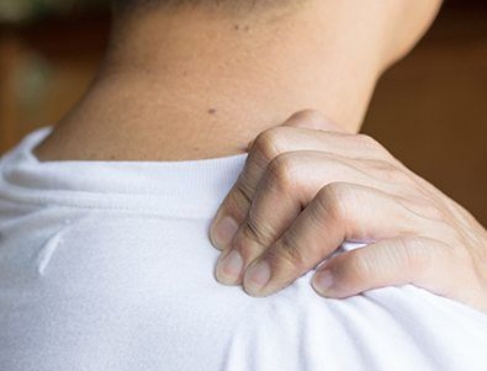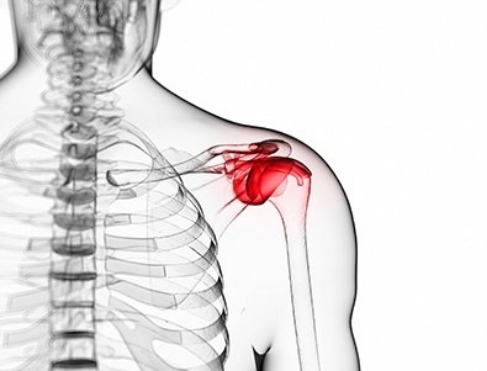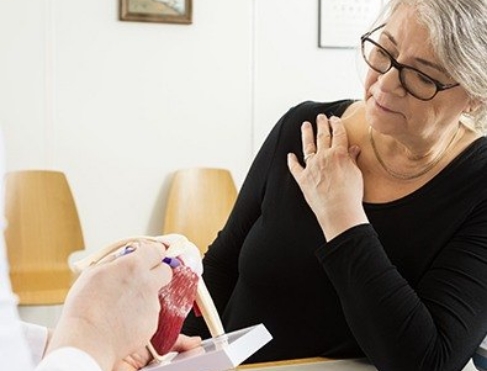Treating Rotator Cuff Tears Glastonbury
Surgery-Free Rotator Cuff Treatment

Your shoulder is a complex joint that is constantly at risk of an injury like a rotator cuff tear, which can be painful and debilitating. Rotator cuff problems are frequent and quite concerning injuries in orthopedic, sports medicine, and musculoskeletal medicine practices. Patients often express apprehension about possibly having a rotator cuff tear, such as, “I hope my shoulder pain isn’t due to a rotator cuff problem.” At New England Stem Cell Institute, Dr. Paul Tortland specializes in the diagnosis and treatment of rotator cuff tears in Glastonbury, and he and his team offer innovative treatments to speed up your body’s natural healing powers.
What is the Rotator Cuff?

The rotator cuff is a group of four muscles and their tendons that help support and stabilize the shoulder joint socket. Each of the muscles attaches to the scapula (the shoulder blade), and the tendons reach around and grab the ball of the shoulder to help hold it in the socket during movement. Sometimes these are referred to as the “SITS” muscles, referring to their names: Supraspinatus, Infraspinatus, Teres minor, and Subscapularis.
The main purpose of the rotator cuff is NOT to rotate the shoulder. Rather, it’s to stabilize and provide support for the entire shoulder joint.
What Kind of Damage Can Occur to the Rotator Cuff?

The tendons and muscles of the rotator cuff can succumb to the same types of injuries as any other muscle or tendon, including sprains, strains, tendinitis, and tears.
What is a Rotator Cuff Tear?

As the name implies, a rotator cuff tear is a tear in one or more of the tendons of the cuff. These can be very small tears within the body of the tendon (known as an “interstitial” tear), massive and complete tears, or anything else in between. Rotator cuff tears are very common, affecting as many as 2 million people in the United States every year.
How Do Rotator Cuff Injuries Occur?

The rotator cuff can be injured in all kinds of ways, but it most often has to do with repetitive overuse, progressive stress over time (from things such as improper weight training), or an acute, sudden injury such as falling on the shoulder or trying to lift something too heavy. The rotator cuff is also vulnerable to degenerative changes that come with aging.
Learn More About How Rotator Cuff Injuries Occur
What are the Symptoms of Rotator Cuff Injury?

Pain while your shoulder is resting is one of the most common symptoms of a rotator cuff injury. You may also experience:
- Pain when lifting your arm
- Pain when lying on the affected shoulder
- A crackling sound when you move your arm
- Muscle weakness during movement
- Pain radiating to the outside of the upper arm, the upper back, the neck, or down the forearm
During an acute (sudden) injury, you could experience a snapping sensation as the rotator cuff tears followed by severe pain and/or sudden weakness. Rotator cuff tears that develop slowly due to degeneration usually cause a dull ache and muscle weakness.
Learn More About Rotator Cuff Injury Symptoms
How are Rotator Cuff Injuries and Tears Diagnosed?

When you come to our office with concerns about shoulder pain, our team can perform a thorough exam to identify the underlying cause of your discomfort. This can include a review of your symptoms and your medical history, as well as a physical exam.
To help confirm whether your shoulder symptoms are due to a rotator cuff injury, a diagnostic ultrasound will also be performed. Ultrasound is an excellent way to visualize the muscles and tendons of the cuff. If there is still any doubt about whether a tear is present, an MRI may be ordered.
How are Rotator Cuff Injuries Treated?

Treatment of your rotator cuff injury will depend on the nature and severity of the injury, your symptoms, and the cause of your injury. For tendinitis and mild tears, your treatment may include:
- Resting and icing the affected area
- Taking anti-inflammatory medication
- Making changes to your physical activities
- Physical therapy
- EWST (extracorporeal shock wave treatment)
- Therapeutic home ultrasound
If conservative methods fail to improve your tendinitis or mild rotator cuff tear, then the team at the New England Stem Cell Institute may recommend regenerative medicine treatments such as platelet-rich plasma (PRP), which when injected into your damaged cuff, can help accelerate the natural healing process.
For larger cuff tears, fat-derived stem cell treatment is often recommended for those persons wishing to avoid surgery. Fat can be an excellent source of stem cells from your own body. Unlike PRP and bone marrow-derived stem cells, fat has the advantage of being almost like putty or filler that can fill in larger cuff tears. This keeps the healing cells in place, so they augment tissue repair. Using a gentle, minimally invasive liposuction technique, we take a small amount of fat from the “love handles” and process it to release the stem cells and other regenerative healing cells. The processed fat is then injected into the tear using ultrasound guidance. For a massive or complete tear, surgery may be required.
Rotator Cuff Injury FAQs
Is a rotator cuff injury similar to a labrum injury?
While these are both common problems that affect the shoulder and can cause similar symptoms, the underlying source of a rotator cuff injury versus a labrum injury is completely different. A rotator cuff injury stems from trauma to the muscles and tendons that help stabilize the shoulder, while a labrum injury involves a possible tear in a cup-shaped rim of cartilage that supports the shoulder. Determining which one is causing a patient’s stiffness and pain is essential to choosing the right treatment.
How long does it take to treat a rotator cuff injury?
The length of time required to treat and recover from a rotator cuff injury can vary quite a bit from patient to patient depending on several factors, such as the severity of the initial injury, the type of treatment used, and how much the shoulder is moved throughout the healing process. Minor injuries can usually be resolved in a few weeks, while more serious ones may take multiple months to address properly. Dr. Tortland will give you a more definitive timeline after he has a chance to perform an exam and assess your situation.
How much does it cost to fix a rotator cuff injury?
This answer depends on the type of treatment a patient receives as well as how serious their injury is. With our regenerative treatments, stem cell therapy typically offers the best results in the least amount of time, but it is more expensive per application compared to PRP and prolotherapy/Prolozone. These less potent treatments may be better suited to someone with only a mild to moderate injury who is also budget-conscious. Fortunately, they are still able to deliver fantastic results, albeit notably slower compared to stem cells.
Would it be faster to get rotator cuff surgery?
Rotator cuff surgery should only be used in the most extreme situations, like a complete tear of one of the muscles. While surgery can be used to repair the tissue quickly, the procedure can be quite expensive and may require a patient to take a lot of time off to recover, which simply isn’t an option for many people. Our treatments are designed to help a patient heal while experiencing minimal interruption to their day-to-day life, plus they cost much, much less compared to major surgery.
